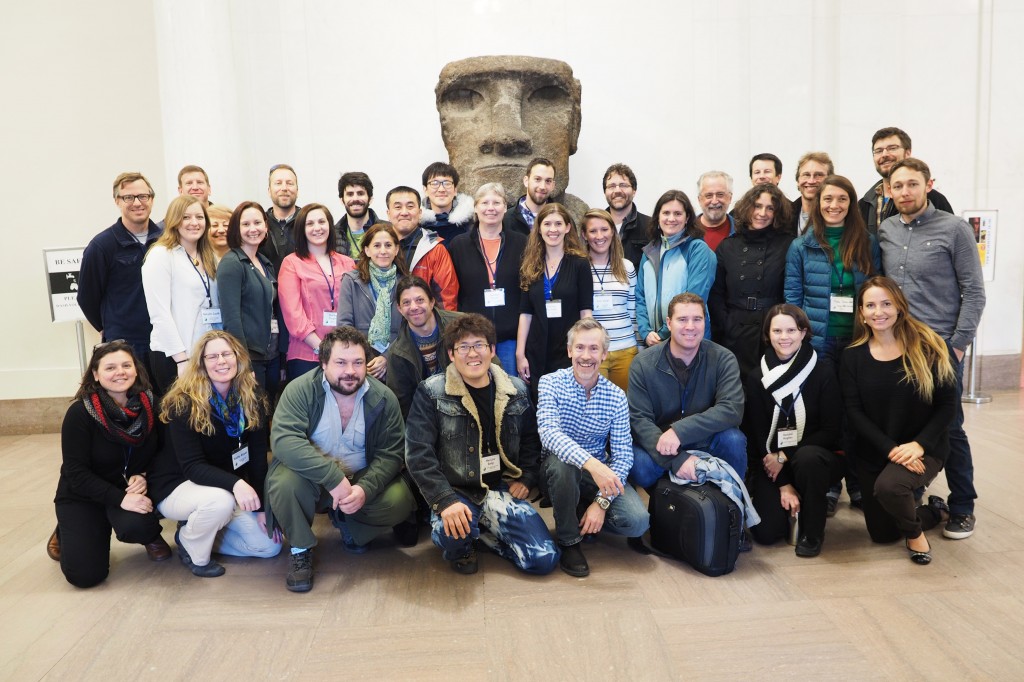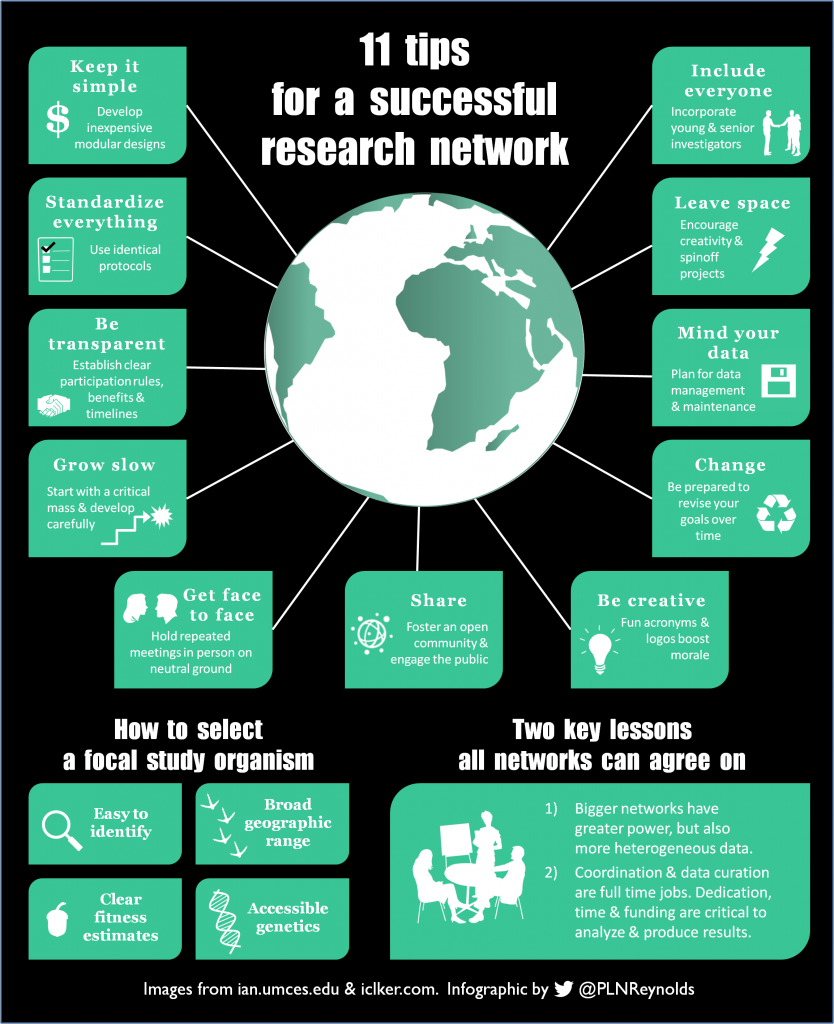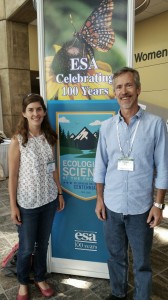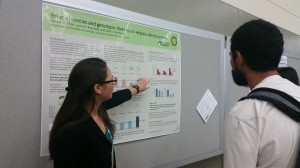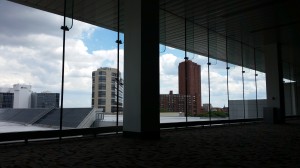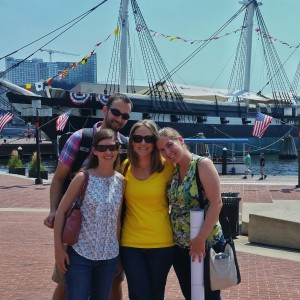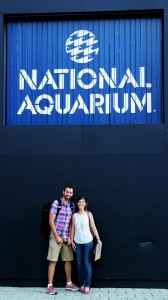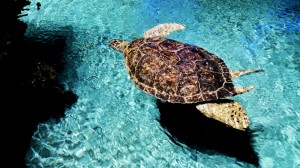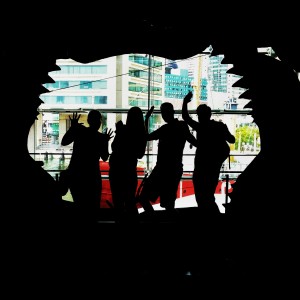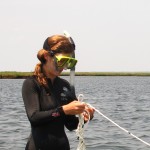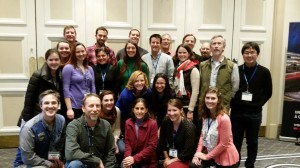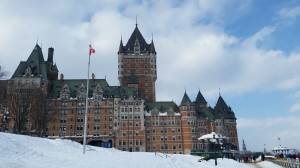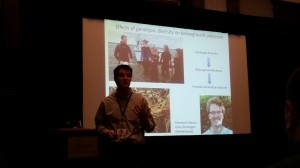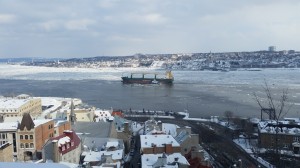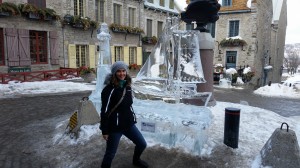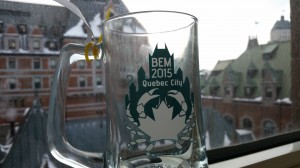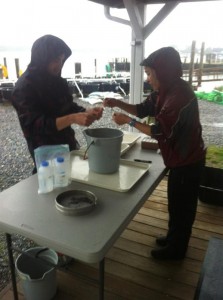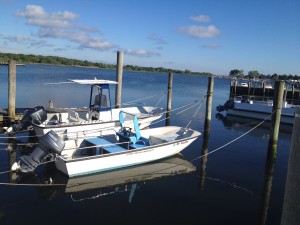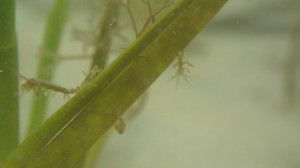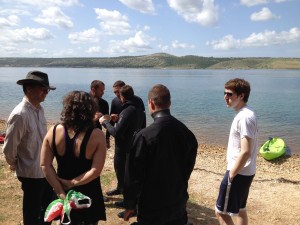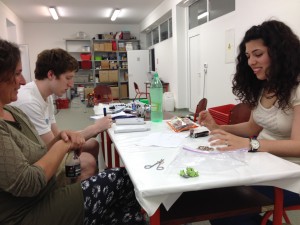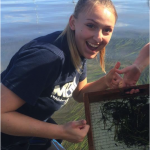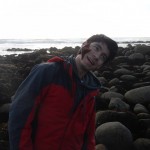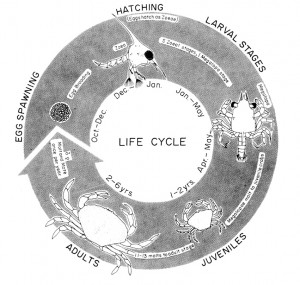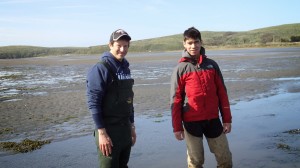Global ecological challenges require large-scale scientific networks
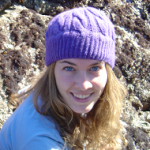 by Pamela Reynolds (ZEN postdoc and coordinator)
by Pamela Reynolds (ZEN postdoc and coordinator)
While at Ecological Society of America meeting (#ESA100) in Baltimore in August, 2015 I attended and participated in the discussions surrounding a special session titled “Collaborative Ecological Research Networks: Sociology, Successes, and Future Opportunities.” I wrote a blog post about this session and the lessons we’ve learned from running ecological research networks like ZEN. This post originally appeared on the PLOS BLOGS website on August 31, 2015 and can be accessed here. The text is included, below, with additional photos. At the end see an infographic I created on “11 tips for a successful research network.”
“It was a big year,” observed Emmett Duffy, director of the Smithsonian Institution’s MarineGEO program, at the 100th Ecological Society of America (ESA) meeting in Baltimore, MD in reference to the society’s establishment in 1915. “World War I was raging, the Lusitania went down, Congress denied women the vote, and John Muir had just died.”
 But, Duffy went on to say, in those dark times Muir had lit a spark and the appreciation of wilderness was growing. It was in this year that the Ecological Society of America was born and began its mission to promote and raise public awareness of ecological science.
But, Duffy went on to say, in those dark times Muir had lit a spark and the appreciation of wilderness was growing. It was in this year that the Ecological Society of America was born and began its mission to promote and raise public awareness of ecological science.
In the century since we’ve vastly improved our understanding of the natural world while simultaneously radically transforming vast swaths of the Earth’s surface.
It struck a chord when Duffy asserted that the once predominantly curiosity-driven and inquiry-based pursuit of ecology to understand nature for its inherent wonder has become eclipsed by today’s model of ecology as emergency medicine based on a need to triage and solve the Earth’s environmental problems.
Scientists are being called upon to tackle increasingly complex issues, which has broadened ecology and driven the need for greater interdisciplinary interactions among us. With global issues such as climate and biodiversity change threatening local ecosystems, large-scale approaches to ecological science have rapidly risen within the field.
A particularly exciting development is the growth of grassroots networks using comparative experimental and observational approaches, which feature simultaneous and unified data collection across multiple locations.
Such research networks allow scientists to directly address large-scale issues by capitalizing on naturally occurring environmental and biological gradients. They work similarly to clinical trials conducted at multiple hospitals to test drug efficacy across diverse demographics – just as a drug might operate differently in younger and older populations so might a given ecological process operate differently at lower and higher latitudes, etc.
Yes, but how?
How can we best organize and sustain these networks given the inherent challenges of managing diverse teams distributed across large spatial distances under shrinking and uncertain funding climates?
Almost four hours of talks, discussion and synthesis by over 50 ecologists at a special session during ESA titled “Collaborative Ecological Research Networks: Sociology, Successes, and Future Opportunities” provided some answers. It also produced more questions about how to leverage such networks to best conduct the next 100 years of ecological research. Here are some highlights from that still emerging dialogue.
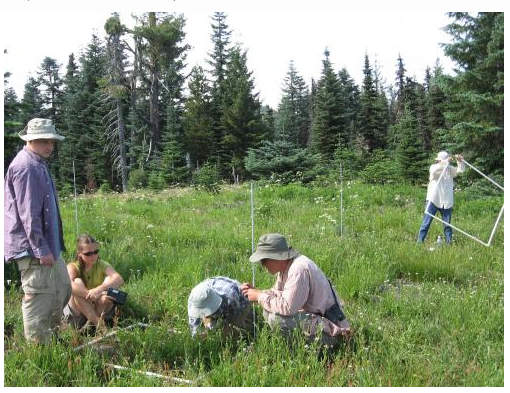
Research networks use identical protocols across broad spatial scales (Nutrient Network Global Research Cooperative)
Eric Seabloom, professor at Univ. Minnesota, opened the session and highlighted several tools scientists have for understanding ecological processes. Traditional single experiments, such as those conducted by a single investigator working in one or a few locations, can provide rigorous tests of specific ecological theory but can rarely be applied directly to other regions. Reviews and meta-analyses of these experiments begin to overcome such context-dependency to uncover overarching ecological patterns, but these approaches lose the benefit of direct comparability as cross-study variation in methodology often emerge as a confounding, or at the very least co-varying, factor.
Observational networks, often in the form of sensor arrays, provide real-time data collected in comparable units. But experimental networks push the envelope of ecological research even further, combining the benefits of the other three approaches with consistent methodology. They provide the opportunity to rigorously, directly test whether our models of nature have global generality and how they are affected by local context. It is thus not surprising that new ecological research networks are emerging rapidly in ecosystems ranging from grasslands and lakes to seagrasses and kelp forests.
Several existing ecological research networks participated in this special ESA conference session.
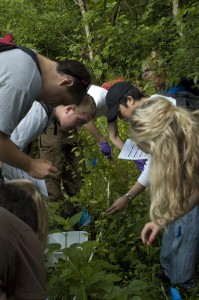
Students and volunteers work with scientists to survey different plant populations for the Global Garlic Mustard Field Survey project (Robert Colautti)
Eric Seabloom spoke regarding the Nutrient Network which studies over 40 grasslands worldwide, Emmett Duffy on the Zostera Experimental Network(ZEN) conducting experiments in 50 underwater seagrass beds across the Northern Hemisphere, and Kathleen Weathers from the Global Lake Ecological Observatory Network (GLEON) which monitors lakes in over 51 countries. Also contributing to the conversation were Ruth Hufbauer from the Global Garlic Mustard Field Surveys featuring academics and citizen scientists tracking approximately 360 globally distributed populations of garlic plants, and Claus Beier from the more loosely aggregated Climate Change Manipulation Experiments in Terrestrial Ecosystems (ClimMani) network.
Despite the tremendous advantages of ecological research networks, the speakers all highlighted significant challenges, especially those inherent to conducting data-intensive research across large spatial scales. Networked ecology comes with a cost – in both infrastructure for project management and data curation.
Additionally, even with numerous broadly distributed sites, there will be data gaps as not all possible locations can feasibly be included. Sites within the network will have some degree of spatial autocorrelation and climate heterogeneity. Incorporating partners from targeted regions encompassing specific environmental regimes can help, but it doesn’t resolve the people and cultural-issues that can arise from such broadly distributed endeavors.
It’s all about the people
Ecological networks rely first and foremost on the people involved – their passion, engagement and commitment to the science – to succeed. The take home message from recent papers on what makes a productive science team is surprisingly simple: 1) members must truly care about the science, and 2) they have to trust each other (Borer et al. 2013; Hampton & Parker 2011).
Network partners have to be willing to invest considerable effort in both time and money, and do so under uncertain terms of any tangible ‘payback’ for their participation. They need to trust that their shared data will be used appropriately and their efforts rewarded. Charismatic, respected and transparent network leadership can help, as can having strong track records of publications and funding. Meeting face to face and repeated informal interactions on neutral ground are critical for helping partners care about, and trust, one another. Clear ground rules and expectations for participation (from data collection, sharing and analysis to publication) must be explicitly established from the beginning. Network leaders must provide effective data management and accessibility and the opportunity for all partners – from professors to graduate students and postdocs – to engage fully in the process. Just as the data itself have needs – to be collected rigorously and according to specific protocols – the people in the network also have needs and supporting both young and senior investigators is critical for network growth and persistence.
Research networks can produce greater quality and quantity of products
Despite the challenges of conducting networked research, the speakers highlighted the important benefits of large-scale collaborations which extend beyond the scope of any specific experiment.
“Network papers and reports are often so well vetted within the network prior to submission to a journal that their quality is very high,” Eric Seabloom noted.
The large community of scientists also helps spur novel research avenues.
“If a network partner comes up with a great idea it’s likely to be adopted and conducted across many sites,” said Elizabeth Borer, professor at Univ. Minnesota and co-founder of NutNet. Eric Lind, a NutNet postdoc, drove this point home with a presentation derived from network data exploring the role of phylogenetic relatedness on grassland biodiversity-functioning dynamics – something the network never set out to test initially but emerged from the years of coordinated data collection.
And, if publications are a measure of network success then GLEON, the largest and oldest of the networks represented at the session, certainly can be proud of Kathleen Weathers’ tally of 143 network publications spanning 356 authors.
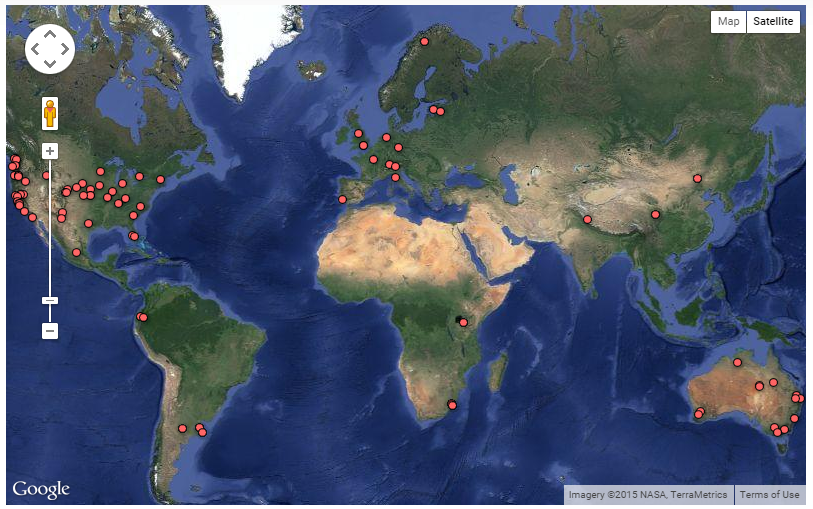
A broad distribution can improve research products, but also poses significant challenges (Nutrient Network field sites, 2015)
Measuring success
While measuring success is critical for network accountability, simply counting the number of publications, citations, or grants doesn’t quite capture the productivity and diversity of positive interactions fostered by those approaches.
Persistence and expansion can be useful metrics, but “growth on its own is not sufficient proof of network success,” said Richard Inouye, Associate Dean at Utah State Univ., as he spoke during the special session about “Networking into the Future.”
Research networks without sufficient age structures, incorporating both young and senior scientists, are unlikely to persist. The best networks should incorporate ongoing opportunities to engage and rekindle existing members across multiple career stages. But, Inouye cautioned, network dissolution isn’t a necessarily a measure of failure either.
“There are many reasons why successful networks may dissolve,” he said. Perhaps the network met its initial goals, solved its main questions. Perhaps the community it created is so well integrated and self-sufficient that top-down oversight is no longer necessary or useful.
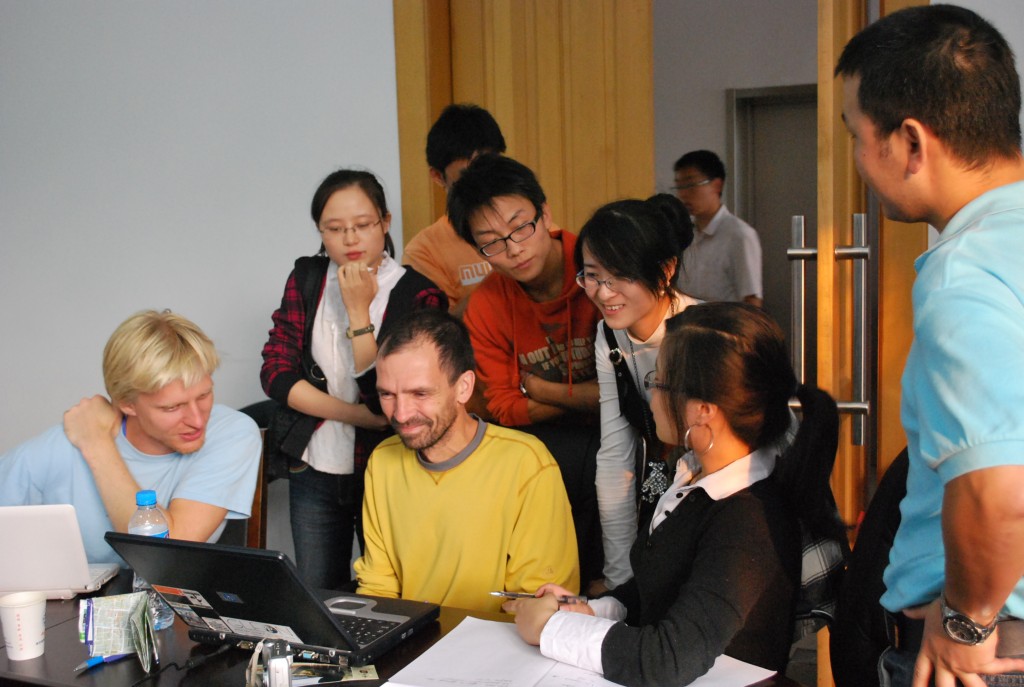
Network persistence requires funding, sufficient age structure, and strategies for data management (GLEON, Grace Hong)
How to provide recognition for the work done?
But, with so many people engaging in a given ecological research network, how can we provide individual participant recognition or measure individual successes?
Authorship on publications is a start, but with large numbers of co-authors the contributions of a given individual can become rapidly diluted. Publishing participation appendices with detailed co-author roles can provide clarification, assuming search and promotion committees take the time to download and read them. Developing network websites with pages highlighting students and other network members who have yet to participate at the level of a co-author can also provide recognition, foster connections among network members, and meet grant reporting purposes.
A personal perspective
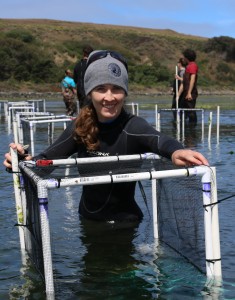
Pamela Reynolds and members of the Zostera Experimental Network sample seagrass biodiversity (Chris Nicolini)
But what continues to amaze me is how strongly participants feel about their networks. Kathleen Weathers was almost nostalgic as she described the strong sense of community fostered by GLEON, who’s first generation of students are now professors running their own labs and continuing to engage in their global lake science.As a postdoctoral researcher and coordinator for the marine ecological research network ZEN, I’ve experienced firsthand the incredible power these networks have in tackling some of Earth’s most challenging environmental issues.
Elizabeth Borer agreed, acknowledging that despite the intense commitment necessary to running a network she still feels, most days, that she gets more out of her involvement with NutNet than she puts in. This is also generally true for the agencies funding such research networks.
“It costs only $4K to setup one of our grassland sites – a site we can typically continue to study for decades,” said Borer.
Our marine network was launched with a single standard NSF research grant,” Emmett Duffy acknowledged, “but the in-kind investment and participation of our partners and their home institutions stretched it to cover 50 seagrass beds worldwide. NSF is getting a tremendous return on this modest investment in a research network.”
As an early career researcher I agree with my network mentors, although inevitably there are days when the coordination and data curation activities are all-encompassing. It is in those moments that the people remind me why I’m in it for the long haul. One day I’m speaking with a researcher in Portugal or Japan, the next North Carolina or San Diego, and their excitement for our science is contagious. In listening to their local, site-based anecdotes I always learn something new – I begin to connect dots I didn’t even know existed, develop perspectives to better understand ecological theory and link our science with important policy. I read an email from a student and realize that their experience working with our network has changed how they think about the world and helped launch their science career.
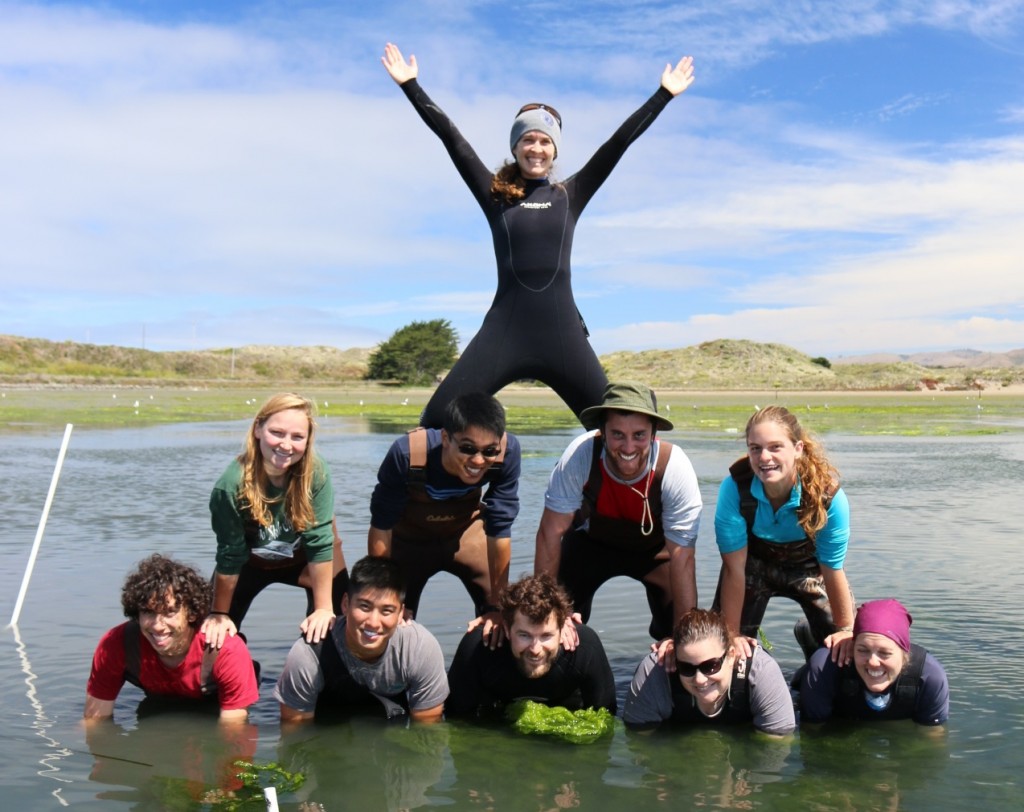
Participating in an ecological research network is rewarding but requires significant dedication (Zostera Experimental Network, Chris Nicolini)
But engaging most deeply with a research network isn’t for everyone. Organizing, motivating and maintaining coordinated research activities (as well as continually searching for funding for meetings, infrastructure and supplies) takes considerable effort. Research networks certainly benefit from the time and energy of junior scientists, but given the longer-term nature of the data collection and slowly accumulating results – which are often at odds with the publish or perish academic culture – some caution is necessary.It’s these types of engagements that keep those of us in research networks coming back for more and motivate us to encourage participation in this open style of science. When networks are done right, junior scientists can expand their networking opportunities and research programs, and established scientists can in turn learn new up-and coming skills.
One strategy is to wait to invest heavily in a network only toward the end of your career or once you are well established in the field. But many of the speakers and participants at the ESA special session presented compelling counter-evidence for that assessment. Like a healthy stock portfolio, scientists at all career stages should engage in a diversity of projects.
For both the sake of advancing science and career, one of those investments we should all make in the next 100 years of ecology is participating in a research network. Collaboration produces rich and diverse rewards for both the investigators and the field at large. Hopefully the next generation of ecologists, and funding agencies, will agree.
Further Reading:
Borer, E.T, Harpole, W.S., Adler, P.B., Lind, E.M., Orrock, J.L., Seabloom, E.W., and M.D. Smith. 2014. Finding generality in ecology: a model for globally distributed experiments. Ecology and Evolution, 5, 65–73. doi: 10.1111/2041-210X.12125.
Hampton, S.E., and J.N. Parker. 2011. Collaboration and Productivity in Scientific Synthesis. BioScience, 61(11):900-910. 2011. doi:10.1525/bio.2011.61.11.9.
Pamela Reynolds is a postdoctoral researcher at UC Davis and the Virginia Institute of Marine Science. Her research explores the causes and consequences of marine biodiversity in a changing world. Her postdoctoral research focuses on seagrass ecology, predator-prey interactions, and salt marsh restoration. Pamela coordinates and manages the Zostera Experimental Network (ZEN), a large international team of marine ecologists. More about her research be found at the ZEN website. Twitter @PLNReynolds.
ZEN at #ESA100
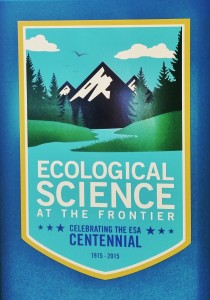 In August 2015 several of the ZEN partners traveled to Baltimore, Maryland to present their research and celebrate the 100th anniversary of the Ecological Society of America (#ESA100).
In August 2015 several of the ZEN partners traveled to Baltimore, Maryland to present their research and celebrate the 100th anniversary of the Ecological Society of America (#ESA100).
This was a very large meeting and a big occasion for the organization - even the president wished ESA a happy birthday!
“Happy 100th birthday to the Ecological Society of America… I want you to know that I’m grateful that ESA has been by our side, helping us bring science to the table to address climate change, preserve our oceans, and combat droughts and wildfires. Your mission and message couldn’t be more urgent. Today like one hundred years ago, you remind us that the health of our nation depends on the health of our environment and I know that you will be at the forefront of this national mission for your next hundred years. So thank you, and congratulations.” – President Barak Obama (Transcript provided by ESA.)
During the meeting, ZEN partner Randall Hughes discussed the use of common garden experiments to test responses of marine populations to temperature change, and her postdoc Torrie Hanley showed legacy effects of eelgrass genotypic diversity on productivity. Mary O’Connor synthesized trends in marine biodiversity losses (and gains), and Joel Fodrie demonstrated the role of landscape context on oyster reef ecosystem services. ZENtern Kendra Chan presented a poster on her undergraduate honors thesis project on the role of eelgrass genotypic diversity and grazer richness on eelgrass decomposition. Pamela Reynolds discussed emerging results from recent ZEN research activities, and Emmett Duffy explained the promise of networks like ZEN for tackling large-scale ecological questions. Pamela live-tweeted while at the meeting - check out her feed @PLNReynolds.
Typically when we attend conferences there is very little time to explore the surrounding city. Most of our time is spent sitting in conference rooms listening to talks, discussing ideas with colleagues in the hallway or over lunch, or hiding in a deserted corner to make some final edits to a presentation.
After the close of the ESA meeting several ZEN participants made a special trip to visit the nearby National Aquarium before traveling home. Here are a few highlights from that visit.
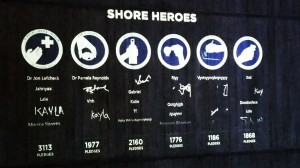
The marine ecologists had fun signing Aquarium pledges for each other to become “shore heroes” and further help the ocean.
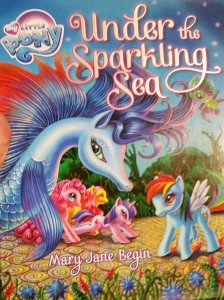
A book in the aquarium’s store brought the week full circle. Before ESA the convention center hosted BronyCon, a convention for My Little Pony enthusiasts.
ZEN Social Media – Send us a like or a tweet!
Did you know that ZEN has a Facebook page? And a Twitter account @ZENscientists? We also have some fantastic partner photos up on Flickr and just started an Instagram account. Follow along and look for ZEN posts and tweets with related hashtags like #SeagrassSunday, #ZENscience, #ZENterns, and #ZENscientists.
First ZEN paper out at Ecology Letters!
by Pamela Reynolds (ZEN coordinator and Postdoc)
We are very excited that our first ZEN cross-site compartative experimental paper is in press in Ecology Letters!
The paper can be accessed here: http://onlinelibrary.wiley.com/doi/10.1111/ele.12448/abstract.
Follow us on Twitter @ZENscientists and Facebook at the Zostera Experimental Network for more updates. Also, I’ll be live tweeting about the new paper throughout the day today @PLNReynolds. Direct message me if you have any questions!
ZEN Meeting in Quebec City, Canada
by Pamela Reynolds (ZEN coordinator & postdoc)
Earlier this month over 30 ZEN participants – faculty, students and staff from over half of our partner sites – met at the annual Benthic Ecology Meeting.
This year the meeting was held in the stunning Chateau Frontenac overlooking the St. Lawrence River in Quebec City, Quebec, Canada. While it was cold and snowy outside, the engaging science made it warm and lively inside. Our ZEN partners presented on their local research – on topics from seagrass habitat fragmentation and mesograzer complementarity, to mutualisms, disease dynamics, biodiversity, and restoration.
While the other meeting participants spent the open session on Friday afternoon to get out of the hotel and explore Quebec’s snowsports, our ZEN partners showed their true dedication by staying to discuss more science and plan for our upcoming field season. We even had 7 ZEN partners – from Vancouver to Sweden – who couldn’t be there in person Skype into our ZEN meeting! These virtual participants engaged with eachother and the in-person meeting attendees during breakout sessions. The feedback from all of the partners was great, and it was a nice opportunity for us to spend some real face time together.
And on the last day of the meeting we did get out a little bit to see the ice floating down the river and explore Quebec City. My favorite was the intricate ice sculptures throughout the city. I even tried the maple syrup on snow, a delightful taffy-like concoction, and did some ZEN “team bonding” with a sledding adventure.
Special thanks to Ladd Johnson and ZEN partner Mathieu Cusson for organizing a wonderful BEM and for facilitating our ZEN meeting.
A little closer to home – ZEN in Long Island Sound
by Ally Farnan (College of William and Mary undergraduate, ZENtern)
Even though Long Island is not a conventionally exotic location for a girl from New Jersey to spend the summer, it is starting out to be quite an adventure.
I arrived on site less than two weeks ago and I already feel like a part of the family here in the Peterson lab. I have spent the past week prepping for the ZEN experiments in the lab. Though a crucial step in the process of running experiments and conducting research, spending a week making aluminum packets, labeling, and weighing tins is not exactly thrilling. It is, however, a necessary part of the process, and is giving me some great practice for the eventual post-processing, sorting, and identification of field samples yet to come. I’m still figuring out where everything in the lab is located, but am getting some excellent help from the other undergraduate volunteers working the lab.
Luckily, I get to start running the actual experiments on Monday, which will also be the first time that I get to see the seagrass bed that we will be working in. Since I have been so busy in the lab, I haven’t had the opportunity to get into my wetsuit and see the site. The area that we are located in is beautiful, so I expect that the study site will also be wonderful!
I’m living a short drive from the lab with two graduate students, which gives me an interesting perspective on how different science research is from the typical 9-5 business job. My housemates, Rebecca and Sam, are excellent hosts and it’s so much fun to hear about the different kinds of research that they do. It should be really exciting to delve further into the experimental stages of ZEN so I can gain some hands-on experience myself.
The lab here is nearby, just off the water. The weather has been great most days, so I’ve been able to explore the area by jogging around town and by the beach. I hope to see some more of the sights around where I am staying. All of my new friends in the lab have given me some great ideas for how to spend my free time during the upcoming weekends - I can’t wait to discover what makes Long Island so special.
It is surprisingly chilly here, so I haven’t been brave enough to go swimming just yet since my toes freeze every time I stick them in the water. But, the sun is constantly shining, making for some beautiful drives around town with my windows down. I can’t wait to continue my adventures here by getting some fieldwork experience. I’ve already packed up my wetsuit so I don’t freeze in the cold water!
I’m so lucky to have a bunch of help in the lab, not only to settle me into a new space and help me to learn more about seagrass ecosystems, but also to advise me on some cold weather gear for our fieldwork in the next few weeks! I’m sure my future blog posts will be filled with some exciting fieldwork stories and hopefully I’ll still have a little free time to explore the area and tell you more about those experiences as well!
A close look at a seagrass creature – caprellids
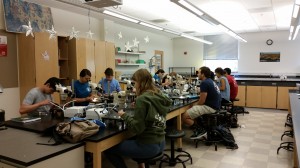
Students in the UC Davis ZEN class sort specimens of mesograzers – small invertebrates that live in seagrass beds
by Elena Huynh (undergraduate in the UC Davis ZEN class)
My first look under the dissecting microscope at a caprellid amphipod was alarming, to say the least. Enormous Claw-like mouthparts and red eyes stared straight back at me and I jumped back in my seat. Lucky for me, no one was there to observe my visceral reaction to this strange looking animal. After taking a moment, I knew that I would need to get comfortable looking at these odd creatures since we would be performing lots of species identifications during the course of the ZEN class at UCD, so I gave it another look under the scope. Despite the permanent menacing stare, this caprellid was not so scary, albeit a bit bizarre. I noticed a deadly looking spike behind its head and paused before learning that this protuberance is a defining characteristic of this caprellid species—Caprella californica!
After observing this caprellid’s scythe-like claws, I wondered what they were used for. As it turns out, caprellids are pretty clingy. They use their claws (gnathopods) and their legs (pereopods) to hang onto seagrass leaves and algae as they either graze the epiphytes that grow on top of the leaves or filter particles out of the water. Some caprellids can actually help seagrasses grow by cleaning the seagrass leaves and increasing their light exposure, increasing their growth. I guess caprellids would make good housekeepers, since they’re constantly cleaning off dirty surfaces.
Out in the field, I had the opportunity to watch caprellids swim. I wondered how these stick figures managed to get around. Through close observation, I noticed that they do a lot of crawling – which makes sense because they don’t appear to have pronounced flippers or large paddles. When they are not clinging to a surface or crawling they get around by moving like a wave. They curl up their bodies then push their feet and head back at the same time, over and over. It is pretty surprising to see what they manage to do with a body plan I’d consider adverse to swimming.
After doing a little research, I found out that some caprellids have hairs on their antennae – called swimming setae – that help them get around (Caine 1979). Although some can swim, they don’t swim very well nor do they swim for very long. If they’re living in beds of seagrass, all they would really need to be able to do is to hop to get from leaf to leaf. Learning more about what caprellids do for a living has helped me appreciate them, and they just might now be my favorite inhabitants of seagrass beds!
For more information, check out: Caine E.A. Functions of Swimming Setae within Caprellid Amphipods (Crustacea). 1979. Biological Bulletin 156:169-178.
“Bok” from Croatia!
by Austin Ruhf (College of William and Mary undergraduate, ZENtern)
Bok, or hello, from Croatia! I’m one of the ZENterns from the College of William and Mary and am spending my summer with classmate Dave Godschalk assisting with the ZEN research in beautiful Zadar, Croatia. I have only been at my host site for a week, but so far Croatia has been a welcoming and easy going paradise. Despite a comical amount of initial bureaucracy (it seemed like we needed the equivalent of a social security registration to gain internet access), the locals have been more than accommodating towards my ignorant American self. My host supervisor at the University of Zadar, Dr. Claudia Kruschel, has been fantastic to work with. She seems to never grow tired and goes out of her way to make sure that all of our work is a group effort. She even lent me her daughter’s guitar so I wouldn’t get musical withdrawal during my stay abroad!
The only downside is that the ZEN field sites are subtidal and are so deep that they have to be surveyed by professional divers. This means that the bulk of my and Dave’s work is done in the lab. The facilities are setup differently from the lab back at VIMS, but the work itself is similar. After a strenuous first week, we have settled into a manageable schedule.
Outside of the lab, fellow intern Dave and I have begun to explore Zadar in our spare time. Dave is already hooked on espresso and sparkling water, and I’m trying to discover more about the culture of the young people here. This led me to watch a heavy metal music show in an old puppet theater, which was pretty strange but somehow felt completely natural. We next hope to visit a few of the world-famous beaches here in Croatia, and learn how to best avoid the crowds of German tourists. Who knew that this was such a popular spot for science, and for a holiday?
A buoyant day in the field
by Whitney Dailey (San Diego State University undergraduate, ZENtern)
One of my favorite parts of the ZEN seagrass ecosystem ecology course at San Diego State University this past spring semester was working in the field and learning about seagrass ecology through a hands on approach.
One field day that I will never forget was when we were collecting our predation intensity experiment. The experiment consists of deploying several “tethers”, which are made by gluing grazers (in this case small grass shrimp or snails) to fishing line placed out in the seagrass bed. We then come back later to record whether the animals have been eaten. The purpose of the experiment is to understand the level of predation in the environment and the relatively susceptibility of different types of grazers.
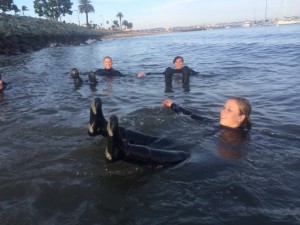
Whitney and classmates at SDSU learn the importance of being prepared for the unexpected – and in bringing weight belts out into the field
However, one of the main lessons that we learned during our time in the field with the ZEN class is that every experiment has its own challenges and the trick is to problem solve and find a way around it. On this particular field day we met the challenge of trying to schedule fieldwork around both our class schedule and the tide. For us this meant struggling to find the tethers in around 3 to 4 feet (1-1.5 meters) of water. While this may not sound challenging, we found it to be very difficult. We would try to dive down, but the extra buoyancy from our wetsuits at that shallow depth made us pop up to the surface right away. So, we just floated on the surface and would reach down and try to find them and pull them out. The trick was not giving up, and remembering to bring a weight belt in the future.
After many failed attempts of trying to retrieve the tethers, we were finally able to hold onto the pieces of rebar we’d installed to mark our experimental plots, and feel around until we found the tether and pulled it out. Every time we found a tether we would get so excited – until we moved on to retrieve the next one. But, with a lot of commitment and perseverance we completed our field day at our ZEN site in San Diego Bay and learned new methods for problem solving during fieldwork. We also learned that in marine ecology (and likely the other sciences) the truly exciting part comes from overcoming challenges, even the ones you didn’t anticipate!
Whitney graduated summa cum laude this May from San Diego State University, receiving her Bachelors of Science in Biology and Environmental Science. She has been working in seagrass ecology as part of Dr. Kevin Hovel’s lab for the past four years including on the initial ZEN projects in 2011-2012. Hailing from Washington, Whitney enjoys playing basketball and taking photographs in her spare time. This fall she plans to being a job as a research technician before applying to graduate school. Whitney will be traveling to work with Dr. Per-Olav Moksnes and his research group in Sweden as par of her ZENternship this summer.
A closer look at an eelgrass inhabitant – the Dungeness crab
by Jason Toy (Undergraduate student in the UCD ZEN class)
Several weeks ago, I was out at Bodega Bay with my classmates from the UCD ZEN course collecting field data for our research projects. As I stood out there in the water in my borrowed waders, I observed quite a few different species of invertebrates as they made their way through the bed of eelgrass. Most were quite familiar to me at that point, but there were a few species, including the Dungeness crab, Cancer magister, that I had not thought of as typical eelgrass inhabitants. I decided to do a little research on the life history of these crustaceans in order to better understand the importance of estuarine seagrass beds to this – and potentially other – important crustacean species.
I was surprised to learn that these crabs move around quite a bit during their life histories. Adults mate in nearshore coastal locations in the Pacific Northwest throughout the spring (Pauley et al., 1989), a process in which the male embraces the female for up to 7 days before she molts, after which the actual transfer of sperm occurs. She stores this sperm for about a month until she extrudes her eggs and, in the process of doing so, they are fertilized (Tasto et al., 1893). But her care doesn’t end there. She protects her eggs by storing them on her abdomen for several months until winter (typically December – January). Then one day, these 1-2 million eggs hatch and the baby crabs leave their mother and enter a 105-125 day planktonic larval period. During this time the young Dungeness crab goes through many developmental changes, moving through 5 zoeal and 1 megalopal stages. After reaching the megalopa stage, the young crabs settle out onto the bottoms of bays and estuaries, where they molt into their first juvenile crab stage and begin to actually resemble real crabs.

During field sampling, Jason and classmates found a few juvenile Dungeness crabs hiding amid the eelgrass in Bodega Bay, California
This is where seagrass comes in! Coastal estuaries (like Bodega Harbor) play a critical role for juvenile Dungeness crabs as a nursery. Large numbers of juvenile crabs benefit from the protection and substrate provided by beds of eelgrass (Zostera marina). They cling to and hide within the grass, consuming other small organisms within the habitat (amphipods, isopods, polychaetes, essentially whatever they can catch!) (Pauley et al., 1989). After several molts, subadults and adult Dungeness crabs begin to leave the eelgrass beds and move offshore, but a few do remain in inland coastal waters, hiding among the eelgrass blades.
The role of seagrass beds in the life history of Dungeness crabs is an important interaction to talk about because it is an example of an economic benefit (known as an ecosystem service) provided by seagrass beds. Seagrasses are critical species in coastal environments around the globe, as they form habitat structure and promote a large diversity of organisms. However, like the coral reefs, they are currently in decline due to the effects of human activities. The connection of an economically important species such as Cancer magister to these seagrass ecosystems, however, can help bring attention to this issue, and provide an incentive for the preservation and restoration of this habitat. Help spread the word!
For more information, check out these references:
Pauley, G. B., Armstrong, D. A., Citter, R. V., & Thomas, G. L. (1989). Species Profiles: Life Histories and Environmental Requirements of Coastal Fishes and Invertebrates (Pacific Southwest): Dungeness Crab. U.S. Fish and Wildlife Services Biological Report 82(11.121): 7-8.
Tasto, R. N., & Wild, P. W. (1983) Life History, Environment, and Mariculture Studies of the Dungeness Crab, Cancer Magister, With Emphasis on The Central California Fishery Resource. California Department of Fish and Game Fish Bulletin 172, 319-320. Retrieved June 11, 2014, from http://content.cdlib.org/view?docId=kt1k4001gs&&doc.view=entire_text
Jason is an aspiring marine ecologist with a passion for all things science. He is a rising senior at UC Davis studying evolution and ecology. His dream job is to be a research SCUBA diver. This summer he will be working in Dr. Jay Stachowicz’s marine ecology lab at UC Davis’ Bodega Marine Laboratory.

